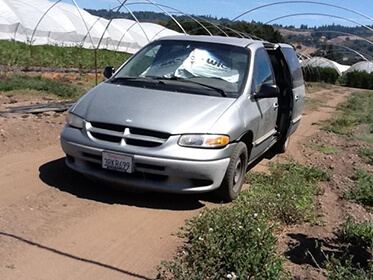
Jobs in transportation industries are expected to grow in the next 10 years.1 Some jobs in transportation, such as flight attendants, are expected to grow faster than average.2 And some transportation jobs, such as bus drivers, have almost as many female employees as males.3 View and share lactation break time and space success stories in transportation jobs.
Lactation break time and space for vehicle drivers and operators
When a woman’s worksite is a car, truck, bus, or other vehicle, it can be challenging to find solutions for lactation break time and space. While a mobile or flexible space such as a car or a pop-up tent may not be ideal, these solutions might be the best way to accommodate breastfeeding employees on the job. Employees who drive or pilot a vehicle for longer than 2 to 3 hours at a time might need an equitable, temporary reassignment if customer or patient safety requirements would be in jeopardy during a lactation break. Non-exempt breastfeeding employees covered by the Fair Labor Standards Act (FLSA) must have reasonable break time and a private lactation space that is not a bathroom. The Break Time for Nursing Mothers FLSA requirement can be seen on the FLSA minimum wage poster (PDF, 147 KB) or notice that must be posted in worksites covered by FLSA.
- Time. Finding time in a driver’s day to take a break to pump every 2 to 3 hours may require creative staffing solutions. While some employees can use regular break times and meal periods to pump or express milk, others may need more support. An employee’s schedule and routes may need to be adjusted to allow more time for standard breaks, since preparation, pumping, and cleanup can take longer than 15 minutes. Also, drivers may need time to get to a private lactation space. Hourly workers can clock out for lactation breaks if they take longer than standard break times. Flexibility on the part of both employer and employee is necessary when a mother is breastfeeding. Supervisors should be aware of the need for lactation breaks if there is unscheduled overtime or extended duty hours.
- Space. Employers can create space for drivers by providing windshield visors or covers ×
 for company cars or vehicles. In the city of Los Angeles, women who are municipal employees can stop at any fire station on their route to use the lactation space in the station. Companies can partner with businesses along an employee’s transportation route to accommodate nursing mothers. A bus company purchased portable restroom shells (without the toilet parts) to put in a maintenance area for private lactation space. Lactation space must not be in a bathroom. Learn more about what employers need to know about the Break Time for Nursing Mothers law.
for company cars or vehicles. In the city of Los Angeles, women who are municipal employees can stop at any fire station on their route to use the lactation space in the station. Companies can partner with businesses along an employee’s transportation route to accommodate nursing mothers. A bus company purchased portable restroom shells (without the toilet parts) to put in a maintenance area for private lactation space. Lactation space must not be in a bathroom. Learn more about what employers need to know about the Break Time for Nursing Mothers law.
Lactation break time and space in other transportation jobs
Transportation support employees, such as flight attendants and parking lot attendants, may need creative lactation break time and space solutions. Other types of jobs, such as mechanics, installers, and repairers, also require creative solutions for lactation break time and space. Solutions can address common challenges, such as environmental, noise, or safety hazards, inflexible schedules for breaks, and limited space for milk expression. Worksites whose employees are covered by FLSA must provide reasonable break time and a private lactation space that is not a bathroom for non-exempt breastfeeding employees. The Break Time for Nursing Mothers FLSA requirement can be seen on the FLSA minimum wage poster (PDF, 147 KB) or notice that must be posted in worksites covered by FLSA.
- Time. Employees covered by FLSA who work long shifts in transportation will need time accommodations when they return from maternity leave if they are still breastfeeding. Some employees can use regular break times and meal periods to pump or express milk. However, if an employee has to step away from duties with the public or customers for a lactation break, she may need a coworker to cover for her or her schedule may need to be temporarily adjusted to allow for shorter routes or duties. Hourly workers can clock out for lactation breaks if they take longer than standard break times. Flexibility on the part of both employer and employee is necessary when a mother is breastfeeding. Supervisors should be aware of the need for lactation breaks if there is unscheduled overtime or extended duty hours.
- Space. Lactation space options for employees whose primary job site is a plane or boat can include any small, private space that is not a bathroom. Curtains or screens can be used to make a space private. The laws in the District of Columbia (DC) and all but one U.S. state protect a mother’s legal right to breastfeed in any public or private space where she has a right to be. Some state laws require specific places, like airports, to have private lactation space available. Some union regulations may address lactation space. Employees who work in large open spaces, like a hangar or repair shop, can temporarily use a private office or a screened-off area in a storage area or employee break room. A lactation space must not be in a bathroom. Learn more about what employers need to know about the Break Time for Nursing Mothers law.
TriMet: a lactation space success story from a bus company
The TriMet transportation company faced unique challenges in accommodating bus drivers who need to express milk. Due to bus drivers’ unique schedules and unpredictable work conditions, the company arrived at a novel solution. They purchased new portable restroom shells (with the toilet parts removed) that were converted to clean and functional private space ×  . Inside the portable lactation space is a chair and a flat surface for the breast pump and supplies ×
. Inside the portable lactation space is a chair and a flat surface for the breast pump and supplies ×  . The portable spaces are placed within a safe, employee-only bus maintenance and rest area along the drivers’ routes.
. The portable spaces are placed within a safe, employee-only bus maintenance and rest area along the drivers’ routes.
Sources
- Lacey, T.A., Toossi, M., Dubina, K.S., & Gensler, A.B. (2017). Projections overview and highlights, 2016–26. Monthly Labor Review. U.S. Department of Labor, Bureau of Labor Statistics.
- U.S. Department of Labor, Bureau of Labor Statistics. (2018). Flight Attendants. Occupational Outlook Handbook.
- U.S. Department of Labor, Bureau of Labor Statistics. (2018). Labor Force Statistics from the Current Population Survey, Table 11: Employed persons by detailed occupation, sex, race, and Hispanic or Latino ethnicity.

